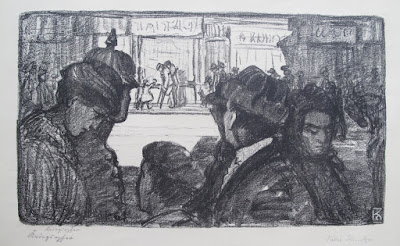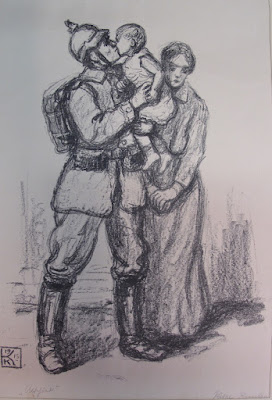Käthe Kuntze
(Part 4)
I have this "feeling", a hunch, the bundle of prints, documents and drawings once may have been in the possession of Käthe: things she kept for herself. There are notes to her printer with detailed requests for altering the plate of one of her etchings. Some have scribbled "Eigen" (own or personal) in a corner and several prints seem (to me) or at least could have had a personal meaning and significance. Besides, who else would have had a reason to keep this mixed and varied lot together besides herself or a close relative ?
Any way, let's continue with sharing some more works I've discovered and in the meantime did my best conserving because they have been suffering from long time neglect although most of them were in pretty good condition.
To begin with: it is remarkable there are several prints with musicians. Remarkable because Käthe was deaf mute and was therefore just an "eye witness". All of these works show great intimacy.
Portraits, a house concert (recital) and a pianist. Could the young violinist be a relative, a brother or nephew and the pianist her sister or a niece ? Pure speculation of course. Hopefully we'll know the answer one day. I've notified the local Radebeul Museum/Gallery of my treasure. All reactions will be shared.
The room in the 1915 house concert/recital etching (without title) has two more interesting features. The windows are "similar" to the windows in her aunts house (I agree this is purest speculation) Haus Albertsberg (see before posting). Could it be ?
And secondly closely examining the audience: the men in the audience facing us are probably wounded soldiers ("Kriegsopfer"), the sitting man holding a crutch. This is obviously a charity concert. This would fit very well to the social status of the Kuntze family, "noblesse oblige" after all.
And secondly closely examining the audience: the men in the audience facing us are probably wounded soldiers ("Kriegsopfer"), the sitting man holding a crutch. This is obviously a charity concert. This would fit very well to the social status of the Kuntze family, "noblesse oblige" after all.
In the bundle were several other works showing Käthe's personal and social commitment and her keen eye observing children. I particularly like this 1915 lithographic drawing above titled "Kriegsopfer", Casualties of War. The composition (it reminds me of Felix Valloton) is brilliant and has several layers of interest, a message build like stage. Käthe who was deaf and mute is obviously trying to tell us something here in something much stronger then words: a haunting image that is carved in the soul inviting to commit oneself to some serious reflection.
And maybe it is also to demonstrate a statement opposing war glorifying pictures like the drawings by propaganda artist Curt Schulz-Steglitz.
The family in the foreground: a young mother with head bend and looking worried, deep in her own thoughts, the boy looking up at his mother (and uncle/father ?). An older women (a mother ?) on the right who could be in mourning. The company sitting in a shaded terrace in a busy street (Dresden ?), the men (the young man with iconic spiked helmet on leave from the front ?) observing the scene on the pavement, in the distance, but nearby just on the other side of the street: a girl offering flowers to a soldier who lost his leg in Flanders trenches. 1915. Closely examining this is a heart breaking and strong political message from a young women in the middle of an atrocious war. And what to think about the horse entering the composition on the right.....? Knowing more about the Kuntze family possibly can tell us also more about her personal involvement with this and other scenes.
And maybe it is also to demonstrate a statement opposing war glorifying pictures like the drawings by propaganda artist Curt Schulz-Steglitz.
The family in the foreground: a young mother with head bend and looking worried, deep in her own thoughts, the boy looking up at his mother (and uncle/father ?). An older women (a mother ?) on the right who could be in mourning. The company sitting in a shaded terrace in a busy street (Dresden ?), the men (the young man with iconic spiked helmet on leave from the front ?) observing the scene on the pavement, in the distance, but nearby just on the other side of the street: a girl offering flowers to a soldier who lost his leg in Flanders trenches. 1915. Closely examining this is a heart breaking and strong political message from a young women in the middle of an atrocious war. And what to think about the horse entering the composition on the right.....? Knowing more about the Kuntze family possibly can tell us also more about her personal involvement with this and other scenes.
In these also created in 1915 large lithographic drawings, she shows, confronts us with "Soldaten spielende Kinder": Children playing soldier. Children do, but should they ?
This also counts for (above) "Kriegstrumpfstricken" children knitting soldiers socks as a war effort, the coordinated mobilization of society's resources. And below: "Abschied". Very powerful and at the same time moving images.
Abschied, Adieu, Farewell !
---------------------
And there's more to come. When you find these postings on Käthe Kuntze: please comment or contact me with more known works by Käthe and if possible biographical facts concerning the Kuntze family in Dresden-Radebeul for sharing.
PS: Thank you Wolfgang in Frankfurt for translating the always difficult to read written in "Sütterlin"script titles.










No comments:
Post a Comment